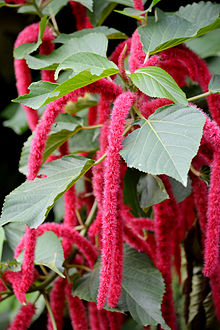Acalypha
| Acalypha | |
|---|---|
 |
|
| Chenille plant (Acalypha hispida) | |
| Scientific classification | |
| Kingdom: | Plantae |
| Clade: | Angiosperms |
| Clade: | Eudicots |
| Clade: | Rosids |
| Order: | Malpighiales |
| Family: | Euphorbiaceae |
| Subfamily: | Acalyphoideae |
| Tribe: | Acalypheae |
| Subtribe: | Acalyphinae |
| Genus: |
Acalypha L. |
| Species | |
|
450-462, see text |
|
| Synonyms | |
|
|
450-462, see text
Acalypha is a genus of flowering plants in the family Euphorbiaceae. It is the sole genus of the subtribe Acalyphinae. It is one of the largest euphorb genera, with approximately 450 to 462 species. The genus name Acalypha is from the Greek ακαλεφης, akalephes ("nettle"), and was inspired by the nettle-like leaves. General common names include copperleaf.
The genus is distributed mainly in the tropics and subtropics, with about 60% of species native to the Americas and about 30% in Africa.
The genus includes annuals or perennial herbs, shrubs, and small trees. Most are monoecious, and some are dioecious. Indumentum of simple hairs or glands, rarely of stellate hairs. The leaves are alternately arranged, undivided, generally petiolate, stipulate; stipels rarely present at apex of petiole or leaf base, caduceus. The blades entire or more frequently dentate or crenate, pinnately or palmately veined. There are several types of inflorescence,terminal or axillary, frequently both, unisexual or androgynous. Male inflorescences spicate, densely flowered, with several flowers at each node subtended by a minute bract. Female inflorescences generally spicate, sometimes racemose or panicle-shaped, with 1–3(–5) flowers at each node, usually subtended by a large bract, increasing and foliaceous in the fruit, generally dentate or lobed; sometimes subtended by a small bract, entire or lobed, non accrescent in the fruit. Androgynous inflorescences usually with female flowers at proximal nodes and male flower at distal nodes.Flowers unisexual, apetalous, disc absent. Male flowers very small, shortly pedicellate, globose in bud; calyx parted into 4 small valvate sepals; stamens 4–8(–16) on a slightly raised receptacle, filaments free or basally connated; anthers with divaricate or pendulous thecae, unilocular, more or less elongated and later becoming vermiform; pollen grains oblate-spheroidal, with 3–5 pseudopores, tectate, psilate; pistillode absent. Female flowers generally sessile or subsessile, pedicellate in a few species; calyx of 3– (4–5) small sepals imbricate, connate at base; ovary of [1–2]3 carpels, surface often muricate, pubescent or papillose; ovules solitary in each cell, anatropes; styles reddish, free or basally connate, several times divided into filiform segment, rarely bifid or entire; staminodes absent.Fruits capsular, small, 3-lobed, soon dehiscing septicidally into 3 bivalved cocci; generally surrounded by the accrescent female bract. Seeds small, ovoid or ellipsoid, usually carunculate, smooth or foveolate; endosperm present, whitish; the embryo straight; cotyledons broad and flat.Allomorphic female flowers present in some species, generally terminal (sometimes median or basal) in the inflorescences; ebracteate, long pedicellate or subsessile; calyx as in the normal female flowers; ovary and fruits 1-2 locular.
...
Wikipedia
